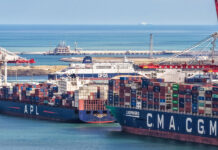
The Panama Canal is experiencing major, ongoing disruptions in the shipping supply chain due to restrictions on traffic related to very low water levels. This is the result of drought conditions that rapidly developed from the beginning of the year through June and have held steady since that time. In fact, 2023 is off to the driest start during January-July since 2015, which had a similar rainfall rate (see figure below). Furthermore, this represents a departure from a long-term wetter trend as reflected by data from 1981-present.
While the low rainfall rate itself is not historic in nature over the long-term, 2023 does show the largest decline in rainfall rate year over year on the record. This sudden drying after a wet 2022 is the likely culprit for the rapid drop in canal water levels.
There has been a slight improvement in rainfall over the past two months, which has resulted in a stabilization of Panama Cana water levels after months of sharp declines. However, rains have not increased enough to raise water levels or to lessen the drought; rather a worsening scenario was simply avoided.
The forecast through the next two weeks does show a more significant period of high rainfall that could finally start to raise water levels in the canal. Unfortunately, high rainfall is likely to be temporary, as the second half of September is likely to feature widespread dryness once again across Panama. Furthermore, season forecast guidance through the end of the year suggests that dry weather could persist. This means that Panama Canal water levels are likely to remain exceptionally low for months ahead yet despite short-term improvements in the forecast.

Author of the article: Isaac Hankes, Senior Weather Analyst at London Stock Exchange Group





